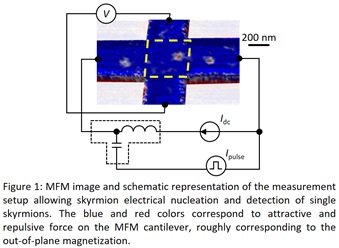
Nicolas Reyren
Unité Mixte de Physique, France
Title: Magnetic skyrmions: Spin torque induced motion and electrical detection at room temperature in metallic multilayers
Biography
Biography: Nicolas Reyren
Abstract
Magnetic skyrmions are small whirling magnetic textures with non-trivial topology, which are usually stabilized by the Dzyaloshinskii-Moriya interaction (DMI). As they are potentially the smallest magnetic textures in magnetic thin films stable at room temperature, they attracted a lot of attention due to their potential applications for memory devices [1].
In 2016, we have shown that sub-100nm skyrmions can be stabilized at room temperature using Ir|Co|Pt-based in 10 repetition multilayers in order to increase the magnetic volume compared to single layer systems, while keeping large DMI (about 2 mJ/m2) [2]. Moreover, we also demonstrated the possibility to nucleate them using current pulses [3-5], and to detect them using anomalous Hall effect [4,5]. In the studied geometry, the topological Hall effect is negligible compared to the anomalous Hall effect, which is sufficient to detect single skyrmions in 500-nm-wide tracks, as we could verify by simultaneous magnetic force microscopy (MFM) measurements (see Fig.1).
Up to now, the spin torque induced skyrmion velocity remains low, partly due to the imperfect materials (with textured crystalline grains) [3]. We indeed also realized that the magnetic textures of the skyrmions along the thickness of the multilayers were more complex than initially thought, contrasting with most of the previous models considering 2D magnetic textures. The internal structure of the skyrmions can be refined using simulations and x-ray resonant magnetic scattering (XRMS) [4,6] at the L3 Co edge.
This new insights should allow us to better engineer the multilayer stacking sequence in order to achieve skyrmion motion at lower current densities and get closer to potential applications.

Recent Publications
1. Fert A, Reyren N, Cros V (2017) Magnetic skyrmions: advances in physics and potential applications. Nature Rev. Materials 2:17031-1-15.
2. Moreau-Luchaire C, Moutafis C, Reyren N, et al. (2016) Additive interfacial chiral interaction in multilayers for stabilization of small individual skyrmions at room temperature. Nature Nanotechnology 11:444-448.
3. Legrand W, Maccariello D, Reyren N, et al. (2017) Room-Temperature Current-Induced Generation and Motion of sub-100 nm Skyrmions. Nano Letters 17:2703-2712.
4. Reyren N, Bouzehouane K, Chauleau J-Y, et al. (2017) Skyrmions in magnetic multilayers: chirality, electrical detection and current-induced motion. Proc. of SPIE 10357:1035724-1-9.
5. Maccariello D, Legrand W, Reyren N, et al. (2017) Electrical signature of individual magnetic skyrmions in multilayered systems. arXiv:1706.05809.
6. Chauleau J-Y, Legrand W, Reyren N, et al. (2017) Chirality in magnetic multilayers probed by the symmetry and the amplitude of dichroism in X-ray resonant magnetic scattering. arXiv:1709.08009.

